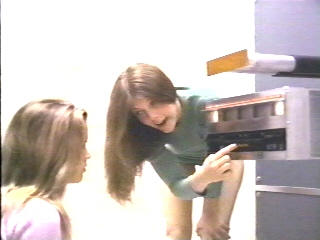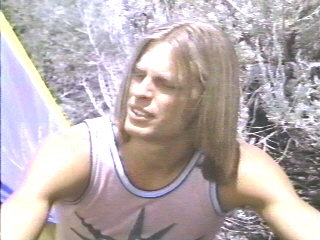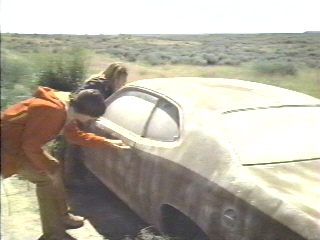
|
|
|
|
|
|
|
|
|
|
|
|
|
(1973) Director: Peter Fonda
Though he may never had had as much fame (positive and negative) or awards as his big sister Jane, I think today Peter Fonda can have the privilege of looking back at a career full of accomplishments. Though he never won an Oscar, he did manage to get nominated one time (Ulee's Gold). Plus, he's been versatile enough to fit in a variety of roles over the decades, starting his acting career playing bikers and hippies, later playing cowboys and mercenaries, and nowadays comfortably fitting the roles of kindly grandfathers in movies like Thomas And The Magic Railroad. And unlike Jane, he's done some work behind the camera. His most famous accomplishment behind the camera is obviously with Easy Rider, which he co-wrote. Besides dabbling with screenplays, however, he has also sat in the director's chair three times. The strange thing is that despite all the fame and
accomplishments he's generated through the decades, all three of the
movies When I first got wind of this movie not long after its video release, I was immediately attracted to it - after all, a long-buried movie directed by someone who's been quite eccentric throughout his career cannot help but make you curious. So soon afterwards I found a copy to rent, and after watching it, I thought... well, to be honest, after so many years I'm having trouble remembering whether I liked it or not at the time. Though a lot of that trouble comes from experiencing another kind of feeling afterwards, one that was stronger than mere like or dislike - utter bewilderment. Perhaps that might have even been how I felt at the time, unable to decide if it was any good or not. Recently, prompted by a reader's request and by my regrowing curiosity, I decided to give Idaho Transfer another look. More than ten years later, I still found it a bewildering experience. But after a lot of thought and examination, I think I can safely say it is not a good movie; it's much too unfocused and incoherent at times, and in its various attempts to be a "message" movie it mostly falls flat. Yet at the same time, the movie has a quiet and subtle, yet powerful energy that captivates you, and leaves you with images and moods that you can't shake off; upon this second glance, I found that even after ten years my recollections of the movie had not been altered with time. So even while I still can't call it a good movie, I think that a movie with this kind of power on you at least can't be considered a terrible one. "Interesting failure" might be one way to put it, but even I think that's a little harsh, despite its serious flaws. With the hippie era not that far in the past when it was
filmed, it's not surprising that the story unfolds in a manner that
would not be considered conventional today. Especially since the
predominately young cast this movie makes it clear it was aimed at the
youths of this period, who were more accepting of the unconventional in
cinema than "the establishment". (Interesting to compare these youths
in this aspect with the youths of today.) For the first part of the
movie as we watch a group of Idaho college students involved in a
secret project, we are slowly given pieces of the puzzle as to just
what they are up to. First of all, we think they have built some kind
of matter-transference machine in the basement of the college building
that enables them to warp from the basement to a haunting Interestingly, we never find out just what disaster - or disasters - that caused the human race to disappear in the future. It does soon become evident that whatever happened was on a gigantic scale, and one of the prime merits of Idaho Transfer is how it manages to deliver the feeling that humanity is gone not only on a poverty-row budget but with a viewpoint that you would not expect. For one thing, during the long hike that the group subsequently takes, we are given very little of the remnants of humanity to look at. During their hike we just see the group come across two or three dusty and beat-up vehicles, a permanently stalled train in the middle of the countryside, and the ruins of two or three small wooden buildings - and that's it. Coming across them only on occasion, they become more haunting to look at than if we saw such sights over and over, especially with them stuck in the middle of this wilderness. Though you might think that the wilderness of Idaho does not lend itself to look unsettling, with some work it does here. Even on my television screen, the outstanding photography still shines, giving us breathtaking shots of the students absolutely dwarfed by the unending plains, volcanic rock fields, and the mountain-sized riverbanks at the edge of incredibly wide rivers - with (except for the students) absolutely no sign that man was ever there. Also surprisingly eerie are the sequences that take place with the time travel machine back at the college. Though the low budget obviously didn't leave much money to construct the machine and make the room that it's in look more elaborate, Fonda again works to present what he has in hand in the best way possible. Except for the surprisingly small time machine itself jammed against one wall, the room is pretty much bare. It's a little creepy seeing the actors entering this large, empty, and dead quiet room that has walls so white they almost glow. Though you might think that the machine itself does not look so fancy on first sight, Fonda makes you believe that it can transport these actors through time. He has the actors playing the scene subdued yet serious, making us feel that these characters have used this machine many times before, though still treat the operation each time with the minimum amount of seriousness needed. When the actors actually transport through time, it's not with any razzle-dazzle. Instead, the silence is punctured by three quiet hums of different pitch blending together, and then the actors fade out during a bout of time-lapse photography. It's such a change from the usual flash and sparkle associated with time travel, you can't help but watch, and even get a little spooked that something so fantastic as time travel is happening in such a low key manner in front of your eyes. The soundtrack and the actors don't just bring
effectiveness to the time travel sequences, but also to the surrounding
scenes. Surprisingly, Keith Carradine, the one "big" name actor the
movie has, only has a role that gives him more or less an extended
cameo before disappearing for good. The rest of the cast is made up of
amateurs, and overall they do a pretty good job. Though their lack of
acting experience does occasionally come across (some of their lines
are not enunciated clearly enough to be understood), they bring an
understated and natural feeling to their characters, and their actions
are not So Idaho Transfer does have a good amount of genuine merit to be found in it. Though as you probably have noticed, I have not mentioned anything yet about its main foundation, its story. Before I get to that, I just want to mention two minor yet still somewhat distracting faults I found with the movie. Well, the first one I can't really call it a fault, because this movie has fallen into the same problem many movies have after a long period of time has passed, and that is that a number of its attitudes and viewpoints seen today in a 21st century light now seem dated. Of course it's possible to see a lot of this as just how many people did feel and act at the time, such as with the casual sex and with one of the girls stating that though she wants kids in this new world, she doesn't care who the father will be. Though even then, it's sometimes hard to picture people so willing to give up the conveniences of modern living in order to live off the land (both in the movie's present as well as the future world), and with one female character at one point stating very casually that she was raped several months earlier. The other minor fault I found was with the movie was with its heavy-handed attempts to be symbolic, or to send a "message". Whether it's an arty shot of a sandwich wrapper falling onto the ground, or a contrived sequence where two of the students encounter some unknowing hippies who claim they don't have a care in the world (causing the students to sadly glance at each other - oh, boo hoo), it always comes across as forced - especially the ludicrous final sequence, which is supposed to pack a punch. Had the biggest fault of the movie not been there, I could have let all of that slide by, but instead it just a few extra shovelfuls onto the frustration generated by the movie. That frustration comes partially from the story never managing to settle comfortably on one kind of focus. First the movie focuses on one character, then soon gets rid of this character. Then we focus on a group of people. Then the movie subsequently focuses on two characters, eventually settling on one of them. As soon as we get comfortable with one particular tone and storytelling, things suddenly change and we then have to readjust. The movie expects us to do a lot of work that ordinarily it should be doing, and it's very distracting. And because the movie keeps jumping from viewpoints, we are often frustrated by characters suddenly disappearing or reappearing in the movie without even a token explanation. It doesn't help that most of the characters are so poorly developed, we are never quite sure who is supposed to be doing what, as well as why a few of the characters take some surprising actions. (I'm still scratching my head as to why the Leslie character did what she did near the end of the movie.) The screenplay simply neglects to connect every person and event with a clear link. As a result, we often simply have to deduce what happened with the little evidence at hand, or wait until much later in the movie for some shred of an explanation. Though it's far from the worst movies ever made, Idaho
Transfer at times proves to be more of a frustrating
experience to watch than many of those movies. Every so often you find
something that really works, clever and eye-catching. But all of these
things are buried in a sea of incoherence, more frustrating than usual
because of it somehow screwing up UPDATE: I received this e-mail from Earl Crabb: "Enjoyed your review of Idaho Transfer, but,
as Evans, the scientist who
Check for availability on Amazon (VHS) See also: Neon City, No Blade Of Grass, Survivor |
 Fonda directed could be considered unknown
enough to be reviewed for this page, all for different reasons. The
Hired Hand does have a small and enthusiastic cult, but try
finding a copy of the rare video at your video store, or even a
broadcast on cable. From what I've heard about Wanda Nevada,
it's no wonder that nobody remembers it, even though it not only stars
Fonda and Brooke Shields, it's more available at video stores. And then
there is Idaho Transfer, the most obscure of his three
directorial efforts. It got almost no screen time when it was released
to theaters, because its theatrical distributor went bankrupt not long
after it acquired the movie. Then it languished in limbo until the late
'80s, when it was finally released on video. Handled by an independent
video label, the movie had little chance of grabbing a new audience,
and today languishes on the shelves of the few video stores that stock
it.
Fonda directed could be considered unknown
enough to be reviewed for this page, all for different reasons. The
Hired Hand does have a small and enthusiastic cult, but try
finding a copy of the rare video at your video store, or even a
broadcast on cable. From what I've heard about Wanda Nevada,
it's no wonder that nobody remembers it, even though it not only stars
Fonda and Brooke Shields, it's more available at video stores. And then
there is Idaho Transfer, the most obscure of his three
directorial efforts. It got almost no screen time when it was released
to theaters, because its theatrical distributor went bankrupt not long
after it acquired the movie. Then it languished in limbo until the late
'80s, when it was finally released on video. Handled by an independent
video label, the movie had little chance of grabbing a new audience,
and today languishes on the shelves of the few video stores that stock
it. volcanic landscape
(filmed at the actual Craters Of The Moon national monument) several
miles away, and back again. That's true, but that's not all - it turns
out that when they transport through the machine, they are taken to
that location 56 years in the future, in a world where humanity has
apparently been wiped out by some kind of environmental holocaust.
Later on, we find out the mission of the students, overseen by the
father of two of these students: A sizable group of these youths will
soon settle into this future world permanently, to claim this world and
to ensure that the human race will not die off.
volcanic landscape
(filmed at the actual Craters Of The Moon national monument) several
miles away, and back again. That's true, but that's not all - it turns
out that when they transport through the machine, they are taken to
that location 56 years in the future, in a world where humanity has
apparently been wiped out by some kind of environmental holocaust.
Later on, we find out the mission of the students, overseen by the
father of two of these students: A sizable group of these youths will
soon settle into this future world permanently, to claim this world and
to ensure that the human race will not die off. overwhelmed by the
flash that celebrities sometimes bring to a movie. Coming across as
cautious, a little uneasy in this new world, you believe these people
exist, and scenes tinged with sadness have an extra kick to them as a
result, such as when two characters check out an abandoned car. A
further boost to these scenes comes with the quiet and melancholy score
playing in the background. A curious mix of an out of tune piano,
thumps, and electronic hums, you'd expect the constant change of music
to be distracting, but it always seems to fit whatever tone the movie
is currently at.
overwhelmed by the
flash that celebrities sometimes bring to a movie. Coming across as
cautious, a little uneasy in this new world, you believe these people
exist, and scenes tinged with sadness have an extra kick to them as a
result, such as when two characters check out an abandoned car. A
further boost to these scenes comes with the quiet and melancholy score
playing in the background. A curious mix of an out of tune piano,
thumps, and electronic hums, you'd expect the constant change of music
to be distracting, but it always seems to fit whatever tone the movie
is currently at. material that you
think would be easy to write and direct clearly. So clearly, there will
be a lot of people turned off by this movie. However, if you are
interested in failed experiments, or like to taste the strange and
unconventional even if things in the end just don't come together,
there's a good chance that you'll find the movie an interesting
experience. In fact, I found the good material in this movie so unusual
and interesting, that I found that this small chunk had a pull almost
as great as the big pile of muck that buried it. Sure, you could do
better... but you could also do a whole lot worse.
material that you
think would be easy to write and direct clearly. So clearly, there will
be a lot of people turned off by this movie. However, if you are
interested in failed experiments, or like to taste the strange and
unconventional even if things in the end just don't come together,
there's a good chance that you'll find the movie an interesting
experience. In fact, I found the good material in this movie so unusual
and interesting, that I found that this small chunk had a pull almost
as great as the big pile of muck that buried it. Sure, you could do
better... but you could also do a whole lot worse.